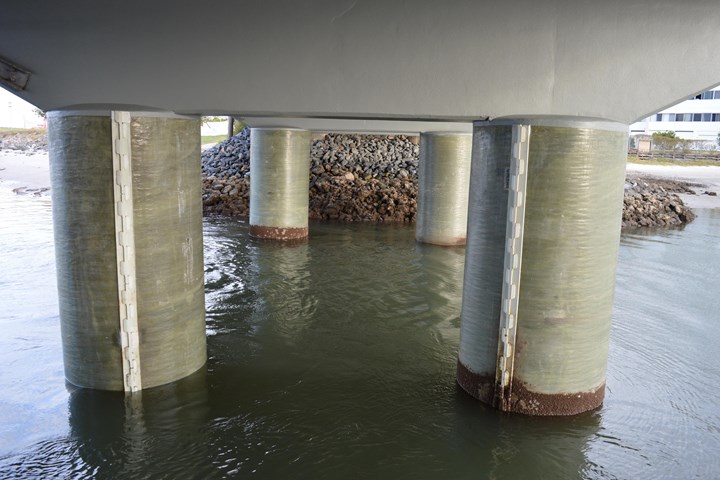Novel composites jacket for structural repair wins research commercialization award
Biomimetic-inspired composite pile repair system shows potential for commercialization in infrastructure rehabilitation.

Bridge pier repair using the prefabricated fiber-reinforced poylmer jacket. Photo Credit: USQ, Joinlox.
Mr. Ali Mohammed, a PhD student at the University of Southern Queensland (USQ, Australia), has been awarded second place for his poster by Innovyz Research Commercialisation Poster Competition, which presented the outcome of his PhD work on novel composites jacket for structural repair.
Innovyz specializes in the commercialization of research from universities and institutions in Australia and New Zealand that can be applied to the future of advanced materials and manufacturing. The Innovyz Research for Commercialisation Poster Competition promotes technologies with commercial application in the advanced materials and manufacturing space. In addition to a cash prize, awardees of the poster competition award will have an opportunity for pitch training and to meet with the Innovyz Commercialisation managers to explore their technology.
Mohammed’s awarded work is a result of a three-year collaborative development project between Joinlox and USQ, which has developed and commercialized a new type of composite pile repair system made of a prefabricated fiber-reinforced polymer jacket. The end product is composite repair with an innovative joining system for infrastructure rehabilitation. The traditional composite repair systems, which are directly wrapped to the damaged structure, are said to typically require a lot of site preparation. Alternately, the technology proposed by Mohammed is quick to install due to its novel easy-fit and self-locking mechanical joining system; the joint’s design mimics the way clam shells close — with precise ease and strength.
Professor Peter Schubel, the director of the Centre for Future Materials (CFM) at USQ commends Ali and his PhD supervisor, Professor Allan Manalo, for receiving such prestigious award. He adds that “this award is a recognition of the innovativeness and practicality of the composite technologies being researched at USQ, especially in the area of advanced materials and manufacturing. The Innovyz Research Commercialisation Poster Award recognizes the innovativeness of the research activities that our PhD students do at USQ and our strong linkage with industries which help brings our developed technologies from research laboratory to commercial application. The prefabricated composite jacket with an innovative joint is a very good example of this.”
The awarded prefabricated composite jacket technology is said to have a significant and wide market potential. Following the successful three-year collaborative development programme with USQ, Joinlox has now commercialized this technology under the trade name “PileJax” and has incorporated it into several bridge rehabilitation projects, including rail bridges across the Gold Coast canal system. In Australia alone, the majority of the 12,000 concrete bridges managed by road authorities, especially those built in aggressive environments, start to deteriorate after only 30 years of service. According to Joinlox, applying this technology will extend service life of to these critical infrastructures by decades at a fraction of the cost.
Related Content
-
Swedish parking garage to incorporate decommissioned wind blades
Architect Jonas Lloyd is working with Vattenfall to design the multistory building with a wind blade façade, targeting eco-friendly buildings and creative ways to remove blades from landfills.
-
Composites-reinforced concrete for sustainable data center construction
Metromont’s C-GRID-reinforced insulated precast concrete’s high strength, durability, light weight and ease of installation improve data center performance, construction time and sustainability.
-
Fiberglass conduit manufacturer grows into new products, infrastructure applications
Texas-based Champion Fiberglass, a five-time CW Top Shops honoree, expands its success in the fiberglass composite conduit market into new applications and products, looking toward future automation and sustainability initiatives.













.jpg;maxWidth=300;quality=90)

